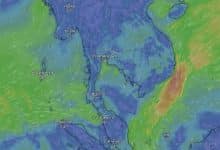PM 2.5 pollution is on the rise in Thailand, warns health official

Particulate Matter (PM) 2.5 pollution is on the rise in Thailand, especially in Bangkok, warns Permanent Secretary of the Ministry of Public Health Dr Opas Karnkawinpong.
PM 2.5 particulates are tiny dust particles so small that thousands of them can fit into one full stop. Inhaling PM 2.5 is detrimental to human health as the minuscule particles travel deep into the respiratory tract, causing eye, nose, throat, and lung irritation as well as coughing, sneezing, and shortness of breath.
Long-term exposure to PM 2.5 can affect lung function and worsen asthma and heart disease. Studies have linked PM 2.5 exposure to increased respiratory and cardiovascular-related hospital admissions, ER visits, and deaths.
Yesterday, Dr Opas said that “orange” levels of PM 2.5 dust were detected in Bangkok and were already beginning to cause health problems.
The doctor recommends monitoring levels of PM 2.5 in your area yourself using the website air4thai.pcd.go.th or the Air4Thai mobile application, which are Air Quality Indexes run by Thailand’s Pollution Control Department. Alternatively, you can just google Air Quality in [insert your location].
The Pollution Control Department’s Air Quality Index tells you whether the PM 2.5 level is blue (very good), green (good), yellow (moderate), orange (beginning to cause health problems), or red (definitely causing health problems).
Dr Opas recommends…
“People with health conditions should reduce outdoor activities or use self-protection equipment if necessary. If you experience coughing, difficulty breathing, eye inflammation, chest tightness, headache, irregular heartbeat, nausea, or fatigue, you should consult a doctor.
“When the PM 2.5 level turns to red, the PM 2.5 dust value is upwards of 91µg/m³. When levels are higher than 91, everyone should avoid outdoor activities. Avoid areas with high pollution levels and use protective equipment if necessary.”
A regular face mask will not protect you from inhaling tiny PM 2.5 dust particles. The only mask that is effective against PM 2.5 is the N95 mask.
You can also improve the air quality in your home with an air purifier.
When PM 2.5 levels are high, the sky appears hazy and visibility is reduced. In northern Thailand, levels of PM 2.5 become the worst in the world from February – April, also known as “burning season.” Farmers burn their crops to prepare for the next harvest, causing pollution levels to shoot upwards to extremely dangerous levels.
Latest Thailand News
Follow The Thaiger on Google News:


























